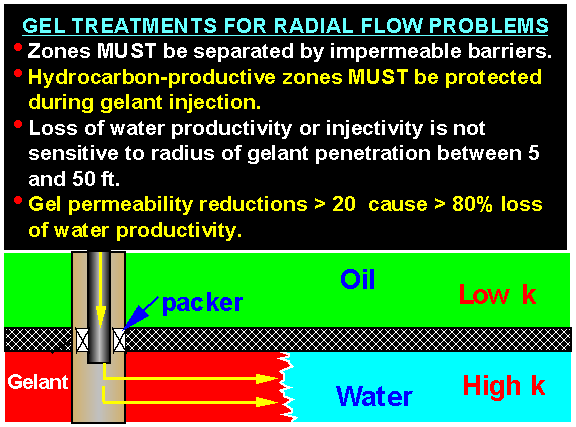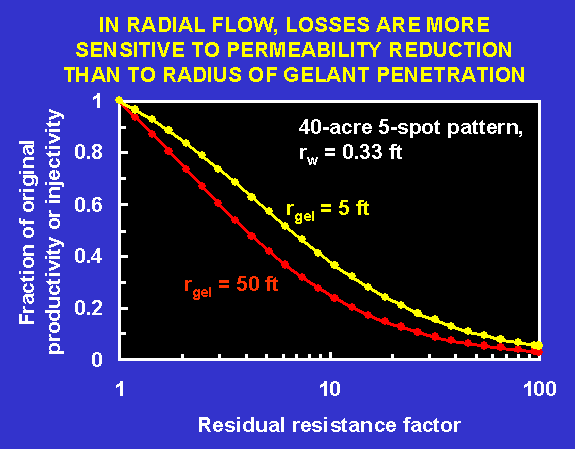Unfractured Wells with Effective Barriers to Crossflow
Problems 3 in Table 1

Often, when radial flow exists around a well (i.e., fractures are not important), impermeable barriers (e.g., shale or anhydrite) separate hydrocarbon-bearing strata from a zone that is responsible for excess water production. When the water zone is located at the bottom of the well, cement or sand plugs are used most commonly to stop water production. When the water zone is located above an oil zone, historically the most common water shutoff methods include cement or carbonate squeezes (into perforations) or mechanical packers or patches27—i.e., the conventional treatments of Category A of Table 1.
However, gels, involving gelant injection, have also been used frequently to treat these problems.7,32,36,41 In these instances, the problem solution falls into Category B of Table 1. Gels have two advantages over cements and carbonates for some applications.36 First, gelants can flow into porous rock, whereas cements and particulate blocking agents are filtered out at the rock surface. Cements (including “micro-fine cement”) only invade and plug porous rock or sands of normal permeabilities (e.g., sandstone and sands of <1,000 md) to any significant distance by fracturing or parting the rock or sand when sufficient injection pressures are provided. If the cement does not adhere adequately to the rock in the perforation or other large void (e.g., because of chemical incompatibility or mechanical shock), the zone may not be sealed sufficiently. In contrast, gels (i.e., after gelation) can form an impermeable rubbery mass that extends past the rock surface, well into the porous rock. Second, gelants and gels can penetrate into and plug narrow channels (e.g., micro-annuli) behind pipe in the vicinity of the zone to be shut off.36 Therefore, in some cases, gels can provide a more effective seal in the zone to be plugged.
When treating radial flow problems using gels or similar blocking agents, hydrocarbon zones must be protected during gelant placement. Otherwise, the blocking agent will probably also damage the hydrocarbon zones.17 Mechanical isolation of zones is the most obvious method to protect oil zones during gelant placement. However, other methods exist—notably dual injection.7,23,42 As an example of dual injection, gelant might be injected down coiled tubing into the water zone while non-damaging water or hydrocarbon fluid is injected simultaneously down the annulus into the oil zone (while the two zones are in fluid communication). Downhole pressure gauges in the tubing and annulus are carefully monitored to maintain a very delicate pressure balance. Near the wellbore, this balance minimizes gelant crossflow into the oil zones and protective-fluid crossflow into the water zone. This method is of particular interest and value for wells where mechanical zone isolation is impractical, especially gravel-packed wells and wells with flow behind pipe. The method and its associated gel treatment will not be effective in cases where laterally extensive barriers (e.g., shale or anhydrite layers) are not present out away from the wellbore.26 The dual injection technique is considered to be an advanced zone isolation technique that must be carefully designed and tailored to individual well problems and often requires computer simulation support for its successful implementation. Refs. 23 and 42 describe field applications of the dual injection technique.
For gel applications in unfractured injection or production wells where crossflow does not occur, how much gel should be injected and what properties should the gel have? This question is easily answered by considering Fig. 1, which was generated using the Darcy equation for radial flow.43 This figure applies to gel treatments both in injection and productions wells.

Fig. 1 plots the fraction of original injectivity or productivity retained after a polymer or gel treatment as a function of the residual resistance factor (i.e., the permeability reduction provided by the polymer or gel). Fig. 1 applies to a waterflooded reservoir with a 40-acre, 5-spot pattern with a unit-mobility displacement. The wellbore radius was 0.33 ft. Two cases of radii of gelant penetration (rgel) are presented¾5 ft and 50 ft. A comparison of these two curves reveals that for a given residual resistance factor, the injectivity or productivity losses are not strongly dependent on the radius of gelant penetration. Therefore, the performance of the gelant treatment is not sensitive to the volume of gelant injected. A five-foot radius of penetration will often be adequate for many applications, if the gel can withstand the high pressure gradients near the wellbore. Fig. 1 also indicates the desired properties of the gel. In the water zones, for the typical range of gelant penetrations, residual resistance factors of 20, 50, and 100, will provide water productivity losses of 80%, 90%, and 95%, respectively. These values are adequate for most radial flow problems.
In some cases where cold water is injected into wells in hot reservoirs, thermal fractures may develop and extend a significant distance (e.g., 10 to 100 ft or more) from the wellbore.44,45 In these circumstances, the gel treatment should plug both the matrix and the fractures in the offending zone.
Many polymers and gels can reduce permeability to water (kw) more than that to oil (ko) or gas (kgas). For the credible experimental data reported to date, polymers and gels may reduce kw more than ko; however, they always reduce ko to some extent. In the best cases, Zaitoun and Kohler46 reported that adsorbed polymers significantly reduced kw at any given water saturation, while the oil relative-permeability curve was basically unaffected by the polymer. However, the polymer increased the irreducible water saturation, thus lowering the endpoint relative permeability to oil. Therefore, for all practical purposes in zones with high oil saturations, the polymer treatment reduces the effective permeability to oil to some extent.
For gel treatments applied to water injection wells, the disproportionate permeability reduction is of no value. However, in production wells, the property is critical to the success of gel treatments if hydrocarbon zones are not protected during gelant placement. Even then, the property is of value only when zones with high hydrocarbon saturation are distinct from the offending water producing zones.47 In other words, this “disproportionate permeability reduction” will not mitigate water production from a reservoir that has effectively only one zone. When a single zone exists, even if the polymer or gel can significantly reduce permeability to water without affecting the permeability to oil, the average fractional flow of water and oil from that zone must remain the same. If the polymer or gel near a production well allows oil to pass but not water, the water saturation will increase near and just beyond the gel bank, thus decreasing the relative permeability to oil until the fractional water and oil flows match the values that existed before the polymer or gel treatment. Therefore, unless a particular zone is at its irreducible water saturation, a polymer or gel treatment will always cause some loss of oil productivity, even if the polymer or gel reduces kw without affecting kw. This loss of oil productivity necessarily will be in direct proportion to the loss of water productivity caused in that particular zone.
A common misconception is that the disproportionate permeability reduction will be of value mainly in treating unfractured production wells where fluid flow is radial around the wellbore. However, two technical obstacles currently impede this type of treatment from being commonly successful. First, if zones are not isolated during gelant placement, then generally, the residual resistance factor (permeability reduction value) in the oil zone must be less than two while the residual resistance factor in the water zone must be greater than 10. The reason for this requirement can be appreciated by considering Fig. 1. For radial flow, relatively small residual resistance factors (Frr) can cause significant injectivity or productivity losses. For example, for a gel radius of 50 ft, a Frr value of 2 causes a 27% loss in productivity, while a Frr value of 10 causes a 75% loss. Both of these losses might be considered unacceptable if these are oil zones. Thus, in unfractured wells, oil residual resistance factors (Frr) provided by the gel must be small.
A second technical obstacle also thwarts the disproportionate permeability reduction from being usable in practice when treating radial flow problems. Especially for gels and/or products of gelation reactions, Frro values less than two may be difficult to achieve in a predictable and controllable manner.33,48 Low Frro values usually mean that gelation was incomplete and the products of the gelation reaction were small gel particles that become trapped in pore throats. These particles occupy a small fraction of the aqueous pore space. Gelation reactions are usually sensitive to pH, salinity, and other factors, and these factors are influenced by the rock lithology and resident fluid composition.33,48 Consequently, small differences in rock lithology and reservoir conditions may significantly change the concentration and size of particles formed during the early stages of gelation—ultimately resulting in residual resistance factors that are unpredictable and uncontrollable.
As will be discussed in the next section, the disproportionate permeability reduction currently is of much greater value in treating linear flow problems (i.e., fractured production wells) than radial flow problems.
When treating water production problems in unfractured reservoirs with barriers to crossflow, gel treatments can be applied in either injection or production wells. Refs. 23, 32, 49, and 50 demonstrate field applications of gel treatments for solving this type of problem.